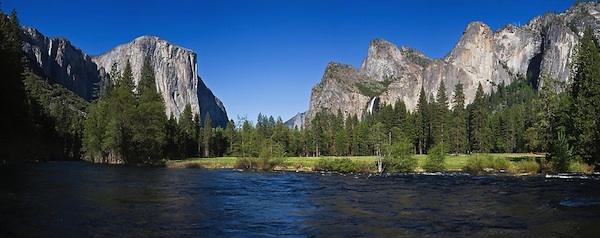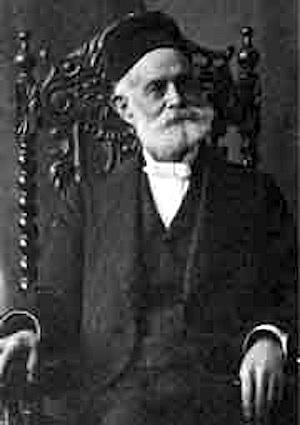
The Yosemite Grant gave birth to the "national park" idea, not Yellowstone/QT Luong, www.terragalleria.com/parks, used with permission.
Now 150 years ago, on June 30, 1864, President Abraham Lincoln signed the act designating Yosemite Valley as the Yosemite Grant. In addition to the valley and its surrounding cliffs, the act authorized the protection of up to four square miles of government land embracing the Mariposa Big Tree Grove, situated approximately 20 miles to the south.
This is to explain why many historians (myself included) consider Yosemite as the birthplace of the national park idea. Certainly, Yosemite realized the idea in fact, if not in name. Even Yellowstone National Park, established eight years later, was referred to as 'a public park' in its enabling act.
Management, not intent, distinguishes the Yosemite Grant from Yellowstone. Both originated as acts of Congress; both withheld scenery on the public lands from private ownership. At the time, Yellowstone was by far the larger park, but chiefly on the assertion that the region needed to be fully explored. When in fact its 'wonders' had been properly located supporters insisted its boundaries could be redrawn.
Because Yellowstone then straddled Montana and Wyoming territories, Congress had little choice but to keep the park. As a state, California was in a position to accept the Yosemite Grant. The unresolved question was how to manage it; that is, appropriately observe what Congress had in mind.
And so the intrigue began. James Mason Hutchings, a claimant and hotelier in the valley, immediately challenged the grant as illegal. Having purchased his hotel in 1863 he insisted the federal government had no right to deny his claim.
The commissioners of the grant disagreed, noting the fundamental stipulation set forth by Congress: 'that the said State shall accept this grant upon the express conditions that the premises shall be held for public use, resort, and recreation; shall be inalienable for all time; but leases not exceeding ten years may be granted for portions of said premises.' The commissioners accordingly offered Hutchings a lease, formally denying that he 'owned' a thing.
As supporting evidence, the commissioners took note of the legal requirements for settlement all across the public lands. Simply put, the bulk of the Sierra Nevada, including Yosemite Valley, had never been surveyed. Before any claimant could expect clear title, the relevant township containing Yosemite (36 square miles) and all relevant subsections had to be surveyed. Each square mile or section within a township further contained four quarter sections of 160 acres each. Such was the allowable claim under the homestead laws, but again, exactly where did Hutchings's quarter section lie?

James Hutchings/NPS
As much to the point, a first claimant was not allowed to sell any part of the 160 acres before obtaining title. The whole purpose of the homestead acts was to ensure that actual settlers received the land. By that definition, Hutchings had purchased his claim from a speculator, and might well be a speculator posing as a settler, too.
Regardless, he insisted he had gotten to Yosemite Valley ahead of the park and had every right to buy an existing hotel. Yet another Yosemite resident, James C. Lamon, similarly argued that being first in the valley gave him absolute rights. Ultimately, the Yosemite commissioners had no authority, the men pronounced, and joined in appealing their case to the legislature.
In February 1868, the California Legislature in fact approved their claims, passing the bill over the governor's veto. However, the Legislature itself was clear; Congress still had the final say. Its 'express conditions' of acceptance did not allow California alone to reverse any terms of the grant.
Now determined to obtain congressional approval, Hutchings personally took his case to Washington, D.C. First in 1868, and again in 1871, the House of Representatives passed the bill he wanted. Sympathy for the settler prevailed in the House. Just as firmly, the Senate refused to concur and did not bring either bill to a vote. Hutchings then filed suit against the state of California'and lost again. Offering Hutchings a last glimmer of hope, the U.S. Supreme Court agreed to hear the case [Hutchings v. Low] on appeal.
Technically, Yellowstone Park, established on March 1, 1872, was also in limbo pending the outcome of the case. Did Congress have the right to establish public parks'or withhold any public lands, for that matter? Finally, in December 1872 the Supreme Court ruled. The rights of the American settler aside, Congress was perfectly within its own rights to establish the Yosemite Grant. The park was both appropriate and constitutional, and not, as Hutchings and Lamon had alleged, an illegal 'taking' of their 'homesteads' in Yosemite Valley.
Consider if the ruling had gone the other way. At least flirting with the possibility, the Supreme Court sided with Hutchings and Lamon that each had applied for a legal homestead. Although there had not been an official survey, the court accepted that each claimant had been sincere. With that, Hutchings and Lamon were halfway to the ruling they wanted. If Congress wished to make public parks, lands previously reserved for another pursuit'any pursuit'could never be involved.
Instead, the Supreme Court upheld the future by affirming the constitutionality of public parks. Congress had been right the first time it had changed its mind. Having previously designated the West for settlement in no way obligated Congress to sell off every acre. "It seems to us a little less than absurd," the court remarked, "to say that a settler. . . by acquiring a right to be preferred in the purchase of property, provided a sale is made by the owner, thereby acquires a right to compel the owner to sell."
Similarly, Congress legitimately might insist on the terms of the transfer. "The act of Congress of June 30, 1864," the court ruled, underscoring the point, passed title of Yosemite Valley and the Mariposa Grove to California "subject to the trust specified therein." As a result, the "act of California, of February 1868," recognizing homestead claims in the valley, was "inoperative" unless "ratified by Congress." But no ratification had ever occurred, "and it is not believed," the court concluded, "that Congress will ever sanction such a perversion of the trust solemnly accepted by the State." (italics added)
We see again the wisdom of the Founding Fathers in establishing three distinct branches of government. Congress itself had come close to reneging on the Yosemite Act, at least, close enough for Yosemite's supporters to breathe a sigh of relief. Thanks to the separation of powers, Yosemite was protected long enough for the majority sentiment in the country to take hold.
Would James Mason Hutchings have protected Yosemite Valley? And James Lamon? That we will never know, because our forebears decided not to take the risk of accepting promises as the basis of preservation.
After all, that formula had miserably failed. If indeed Yosemite marks the origins of the national park idea, then its earliest catalyst was Niagara Falls. With every acre surrounding the falls privately owned, no American could doubt for a moment the fate awaiting Yosemite if Congress failed to act.
As the despoliation of Niagara proved, a promise goes only so far. The decision in Hutchings v. Low then carried preservation into the modern age by allowing the public lands to be used for parks. Recall that practically every national park established over the coming century would be carved from the public lands.
It all started with Yosemite Valley exactly 150 years ago. Over the next eight years, the entire concept of public parks would be tested by Congress, the state of California, and the U.S. Supreme Court. To reemphasize, Yellowstone was the beneficiary and not the originator of that most important test.
As for James Mason Hutchings, he received generous compensation, if not the heart of Yosemite Valley he fought to own. And certainly his combative spirit cleared the air. His motives notwithstanding, he set in motion the process by which the national park idea would reclaim the best of the American land for us all.



Comments
Another great read from Alfred Runte--thanks.
Thank you, Dr. Runte. Stories like this one should serve as reminders to all of us that our parks are not universally accepted as valuable places that need and deserve our protection.
I'm currently reading National Parks and the Woman's Voice by Polly Welts Kaufman. That book and your article here reminded me that nothing much seems to change except the actors in the play. From the very beginning our parks have been constantly faced with surviving the struggle between those who can see only short-term gains that might benefit just them or a small group and those who are able to envision and seek a farther goal that will benefit not just a few.
Reading this book made me realize that without the efforts of thousands of women around the country, our national parks would probably be a paltry fraction of the wondrous places they are today. The author points out that when men were involved in deciding what to do with potential park lands, they tended to see "practical" things. Things like resources or possible opportunities for profit. Women, on the other hand, saw those places for their beauty and as places to help people of all kinds to "become better people."
It struck me that even the words used by those who support and those who oppose efforts to maintain our current parks and to establish new ones are almost exactly the same. A century or more of contention doesn't seem to have changed in anything but the small details of whatever the current argument may be.
Ew, yuck, do we have to get into this "who was first?" argument again and again? Yosemite deserves its birthday party but its founding as a park did not precede that of Hot Springs AK or the numerous timber reserves that were forerunners of our national forests and parks. Yeah, it's special. But it wasn't so much a first as it was a new and different instrument of conservation.
Kurt,
I wish you would just delete the offending posts rather than end what is otherwise a civil discussion.
If two or three readers want to discuss mountain bikes vs hiking ad infinitum, I would suggest you take it to the Forums. But repeating the argument over and over and over again does not forward the post in question.
Agreed, Kurt. The center of the conversation had clearly shifted away from the specific topic of Drake's Bay and the Supreme Court.
Conveniently leaving Hot Springs (in Arkansas) out of the article serves to maintain a narrow but all-too-accepted narrative of conservation that is based on Mountain Majesty Bias.
Dittos Alfred Runte, another educational read.